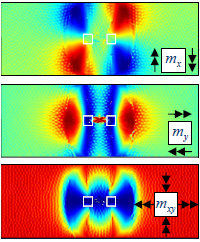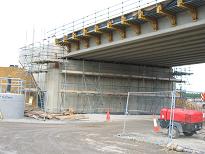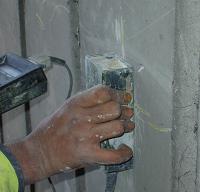Bridge Research Group: Research
Plastic analysis
Traditional elastic methods of analysis, such as grillage and finite-element
analyses, have often been shown to produce overly conservative (albeit safe)
estimates of the load-carrying capacity of concrete structures such as
bridges. Plastic analysis methods, such as yield-line analysis, often
produce much better predictions of capacity, but their use has been
limited by the need to postulate possible modes of failure, with the
inherent risk of missing a  potentially critical mode. Work within
the Group has resulted in a computer program that allows very rapid
analysis of a large number of potential mechanisms suitable for bridge
slabs with relatively simple geometries, and has made yield-line analysis
a practical proposition for the assessment of reinforced-concrete slab
bridges. The program has been made available through the University's
technology transfer company, Cambridge Enterprise Limited, and has
now been in use with a number of bridge owners for over a decade.
potentially critical mode. Work within
the Group has resulted in a computer program that allows very rapid
analysis of a large number of potential mechanisms suitable for bridge
slabs with relatively simple geometries, and has made yield-line analysis
a practical proposition for the assessment of reinforced-concrete slab
bridges. The program has been made available through the University's
technology transfer company, Cambridge Enterprise Limited, and has
now been in use with a number of bridge owners for over a decade.
Recent work has resulted in a new lower-bound plastic analysis technique. Used in conjunction with an upper-bound yield-line analysis, this new technique could provide assessing engineers with a high degree of confidence in the accuracy of their assessments, since if the two analyses (upper and lower bound) produce similar results, the capacity can be determined to be within a narrow range.
Structural health monitoring
The Bridge Research Group has been part of a of large multi-disciplinary research project looking at wired and wireless monitoring of civil infrastructure, including tunnels, water pipelines, and of course - bridges.
 Much of the work has involved using low cost, low power wireless sensors. These
sensors have the potential to allow infrastructure owners to deploy a
structural health monitoring system at quickly and at low cost as there is
no need to install large amounts of power and data cabling, but have the
disadvantage of limited battery life and potentially unreliable data transmission.
Much of the work has involved using low cost, low power wireless sensors. These
sensors have the potential to allow infrastructure owners to deploy a
structural health monitoring system at quickly and at low cost as there is
no need to install large amounts of power and data cabling, but have the
disadvantage of limited battery life and potentially unreliable data transmission.
The Group have deployed wireless relative humidity sensors in the northern anchorage room of the Humber Bridge in order to monitor the performance of the de-humidification units. Wireless inclinometer and crack-width sensors have also been deployed on the Ferriby Road Bridge.
The Group have also investigated the use of inexpensive fibre-optic telecommunications cable for structural health monitoring of concrete beams. When a new bridge was built just to the south of Cambridge new Addenbrooke's Hospital, it was possible to install a number of cables on the reinforcing steel prior to the concrete being poured.
Reliability and Whole-Life Costing
 Throughout the world many countries have instigated assessment programmes to confirm
the load carrying capacity of their bridge infrastructure. If the bridge is found to be
inadequate, a site investigation is often undertaken. A detailed
review of site investigation reports obtained from consultants in the UK has highlighted
a surprising variability in the data obtained during such inspections.
Throughout the world many countries have instigated assessment programmes to confirm
the load carrying capacity of their bridge infrastructure. If the bridge is found to be
inadequate, a site investigation is often undertaken. A detailed
review of site investigation reports obtained from consultants in the UK has highlighted
a surprising variability in the data obtained during such inspections.
Another trend in bridge management is the use of reliability and probabilistic approaches to assessment, maintenance and whole-life costing. Work within the group has looked at the corrosion models for steel, strength distributions among populations of steel bars from different mills, and including the consequences of failure to the community of the failure of a bridge asset in addition to likelihood of failure as a means of prioritising maintenance.
